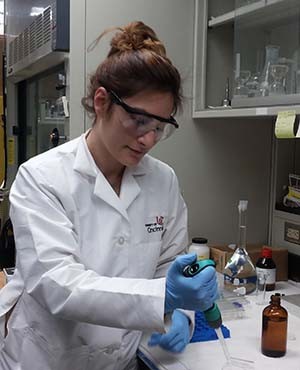
UC Researchers Awarded NSF Grant to Develop Water Sensors
The National Science Foundation awarded researchers at the University of Cincinnati a grant to develop better ways of detecting deadly bacteria in sources of drinking water.
The grant is funded by the
CBET Division of Chemical Bioengineering Environmental and Transport Systems
of NSF. The goal is to develop highly-selective and fast-responding sensors for the detection and quantification of toxins in drinking water and its sources.
The presence of high concentrations of cyanotoxins in several freshwater lakes and streams, some of which serve as sources of drinking water, seriously threatens human and environmental health. In 2014, for example, the cyanobacterial harmful algal bloom in Lake Erie affected drinking water for more than 500,000 people in Toledo, Ohio, according to a recent
.
The project, entitled
Nanosensor for the Point-of-Use Detection of Hepatotoxic Microcystins in Water
, specifically will develop and test a novel sensor designed to detect and quantify algal toxins frequently found in fresh water.
This research aims to address the urgent need for rapid on-site monitoring and the quantification of microcystins in surface waters experiencing algal blooms. Microcystins are a group of frequently found cyanotoxins in fresh water experiencing problems with algae blooms.
We are honored to receive support from NSF. The award will allow us to continue our research activities and directly advance the knowledge and understanding while also promoting teaching, training and learning at UC. Through this research effort, we look forward to creating vital solutions in the realm of water quality and we hope to get closer to presenting a point-of-care sensor for environmental applications to UC and the scientific community, said Dionysios Dionysiou, leader and principal investigator of this grant.
Dionysiou, a PhD and a professor in the
Department of Chemical and Environmental Engineering
in UC's
College of Engineering and Applied Science
, or CEAS, is an expert in water quality research. He has examined topics such as the remediation of harmful algal blooms, contaminants of emerging concern, environmental nanotechnology and water sustainability, among others.
When focusing on big ideas, interdisciplinary teamwork is the key in advances of critical thinking and problem solving, Dionysiou said.
Another leader on the project is co-principal investigator William Heineman, a distinguished research professor and expert in electroanalytical and bioanalytical chemistry in UC's
McMicken College of Arts and Sciences
. Heineman focuses on the development of the electrochemical biosensor aspects of the project.
Vesselin Shanov, CEAS professor of chemical and
and director of UC's Nanoworld Lab, also serves as co-principal investigator. His expertise is in the synthesis and application of carbon nano-structured materials such as carbon nanotubes and graphene. Shanov's efforts in this project will focus on employing nano-structured carbon as an active electrode of the developed sensor.

Professors Dionysiou, Heineman, and Shanov
The University of Illinois at Chicago's Ian Papautsky is a partner on this project, specializing in the investigation of microfluidic systems.
The project aims to create nano-structured biosensors for selective identification and quantification of toxins in water. Two outcomes are targeted: to demonstrate nano-structured sensors for point-of-use determination of toxic compounds and to validate sensor performance with real-world water samples. The fabricated device will be evaluated for its ability to detect and quantify toxins in streams or lakes that can harbor cyanobacteria.
This study will also provide a fundamental understanding of the principles for creating nano-biosensors used in selective identification and quantification of a wide range of organic and inorganic toxic compounds in natural water environments, Dionysiou said.
The researchers hope to provide a significant contribution to the field of nano-biosensing for monitoring water quality. The nanotechnology-based biosensors introduced in this research can be developed for in-situ monitoring of water contaminants and will have tremendous implications for managing sources of drinking water and protecting human health. Additionally, these efforts could prove to be complementary to ongoing efforts to restore and sustain waterways.
This NSF award will benefit students from underrepresented groups, while growing productive academic community partnerships, Dionysiou said. Bringing together a research team of graduate students, undergraduate students, postdoctoral fellows and faculty will directly advance the knowledge and understanding while promoting teaching, training and learning.
Vasileia Vogiazi, a student research assistant working on this project for her doctoral studies, agrees.
Innovative and interdisciplinary approaches will be key in dealing with tomorrows scientific challenges. This is a great opportunity for me to develop the skills to meet those challenges, Vogiazi said.
Related Stories
UC Journalism to host Hall of Fame, Young Alumni Awards
Event: April 24, 2025 6:00 PM
The College of Arts and Sciences’ journalism department will host the Hall of Fame and Young Alumni Awards to celebrate the achievements and accomplishments of its graduates. Induction into the UC Journalism Hall of Fame is a special honor reserved for UC alumni who have excelled in the profession of journalism and media, or individuals who have made a significant contribution to journalism at UC.
UC Honors students gain hands-on research experience
April 1, 2025
The Biomedical Research and Mentoring Program is open to any University Honors Program students. The faculty mentors are typically from UC’s College of Medicine or Cincinnati Children's Hospital.
UC engineer applying generative AI to smart manufacturing
March 31, 2025
Manish Raj Aryal, a PhD student in mechanical engineering at the University of Cincinnati, is working on revolutionizing manufacturing systems through generative AI, leveraging AI systems to develop manufacturing assistant chatbots. He came to UC for his master's degree and continued researching as a PhD student. He was named Graduate Student Engineer of the Month by the College of Engineering and Applied Science (CEAS).
